A) Q1
B) Q2
C) Q3
D) Q2 - Q1
Correct Answer

verified
Correct Answer
verified
Multiple Choice
Exhibit 4-1 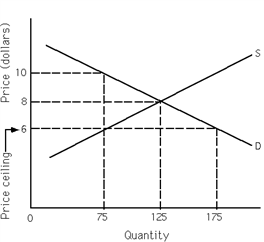 Refer to Exhibit 4-1. Some buyers will offer sellers $7 per unit instead of the $6 price ceiling because
Refer to Exhibit 4-1. Some buyers will offer sellers $7 per unit instead of the $6 price ceiling because
A) $7 is closer to the equilibrium price and buyers prefer equilibrium prices to all others.
B) they think it is only fair for sellers to receive higher prices.
C) they want to increase their chances of buying a good for which there is a shortage.
D) it is customary to pay more than the price ceiling.
Correct Answer

verified
Correct Answer
verified
Multiple Choice
Suppose the government imposes a price ceiling above the equilibrium price of a given good. Which of the following is the most likely result?
A) Some other rationing device will emerge to allocate the good among buyers.
B) Some buyers and sellers will be willing to risk breaking the law in order to exchange the good at a price above the equilibrium price since there would be a shortage of the good at the price ceiling.
C) No change will occur in the market.
D) Brute force will be used to allocate the good among buyers.
E) a, b, and d
Correct Answer

verified
Correct Answer
verified
Multiple Choice
A price floor set above the equilibrium price will
A) clear the market for the good.
B) result in a shortage of the good.
C) result in a surplus of the good.
D) force some firms in this industry to go out of business.
Correct Answer

verified
Correct Answer
verified
Multiple Choice
Exhibit 4-11  Refer to Exhibit 4-11. Suppose that the government imposes a price floor in the market for good ABC at a price of $7. The result of the price floor would be a ____________ of ______ units of good ABC.
Refer to Exhibit 4-11. Suppose that the government imposes a price floor in the market for good ABC at a price of $7. The result of the price floor would be a ____________ of ______ units of good ABC.
A) shortage; 110
B) surplus; 110
C) shortage; 30
D) surplus; 30
Correct Answer

verified
Correct Answer
verified
Multiple Choice
Exhibit 4-8 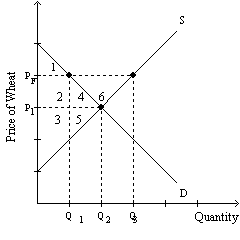 Refer to Exhibit 4-8. If the wheat market is in competitive equilibrium the total surplus will equal
Refer to Exhibit 4-8. If the wheat market is in competitive equilibrium the total surplus will equal
A) area 1 + 2 + 3 + 4 + 5
B) area 1 + 2 + 3
C) area 2 + 3 + 4 + 5
D) area 4 + 5
Correct Answer

verified
Correct Answer
verified
Multiple Choice
Exhibit 4-9 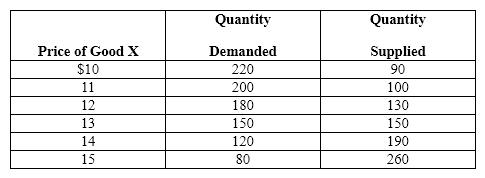 Refer to Exhibit 4-9. Suppose that the government imposes a price ceiling at a price of $11. How many fewer units would be exchanged at the price ceiling than would be exchanged at the equilibrium price?
Refer to Exhibit 4-9. Suppose that the government imposes a price ceiling at a price of $11. How many fewer units would be exchanged at the price ceiling than would be exchanged at the equilibrium price?
A) 50
B) 30
C) 40
D) 70
Correct Answer

verified
Correct Answer
verified
Multiple Choice
Which of the following statements is true?
A) Price ceilings set below the equilibrium price cause shortages.
B) Surpluses result when a price floor is set below the equilibrium price.
C) Price ceililngs set above the equilibrium price cause surpluses.
D) Price ceilings are set by the market and price floors are set by the government.
Correct Answer

verified
Correct Answer
verified
Multiple Choice
Exhibit 4-11  Refer to Exhibit 4-11. Suppose that the government imposes a price floor in the market for good ABC at a price of $7. How many fewer units would be bought and sold at the price floor compared to the number of units that would be bought and sold in a free market?
Refer to Exhibit 4-11. Suppose that the government imposes a price floor in the market for good ABC at a price of $7. How many fewer units would be bought and sold at the price floor compared to the number of units that would be bought and sold in a free market?
A) 20
B) 30
C) 40
D) 60
E) 80
Correct Answer

verified
Correct Answer
verified
Multiple Choice
Exhibit 4-8 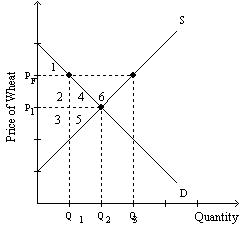 Refer to Exhibit 4-8. If the wheat market is in competitive equilibrium the producers' surplus will equal
Refer to Exhibit 4-8. If the wheat market is in competitive equilibrium the producers' surplus will equal
A) area 1 + 2 + 3
B) area 1 + 2 + 4
C) area 3 + 5
D) area 1 + 2 + 3 + 4 + 5
E) area 6
Correct Answer

verified
Correct Answer
verified
Multiple Choice
When the price of a good falls, the price is transmitting information indicating that the good has become relatively
A) scarcer.
B) less scarce.
C) more plentiful in demand.
D) relatively more abundant.
Correct Answer

verified
Correct Answer
verified
Multiple Choice
Exhibit 4-9 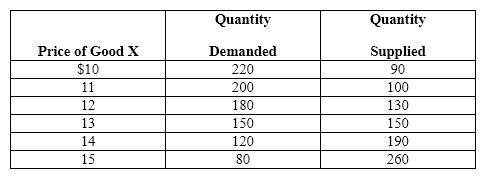 Refer to Exhibit 4-9. Suppose that the government imposes a price ceiling at a price of $10. _________ units would be exchanged in a free market, and ____________ units would be exchanged with the price ceiling in effect.
Refer to Exhibit 4-9. Suppose that the government imposes a price ceiling at a price of $10. _________ units would be exchanged in a free market, and ____________ units would be exchanged with the price ceiling in effect.
A) 150; 220
B) 150; 70
C) 110; 180
D) 150; 90
Correct Answer

verified
Correct Answer
verified
Multiple Choice
If the absolute price of a car is $20,000 and the relative price of a computer is 20 cars, it follows that the absolute price of a car is
A) $400.
B) $4,000.
C) $100.
D) $1,000.
Correct Answer

verified
Correct Answer
verified
Multiple Choice
Exhibit 4-3 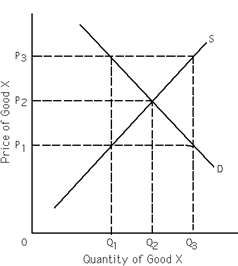 Refer to Exhibit 4-3. The maximum (per-unit) amount buyers are willing to pay to purchase Q1 units is
Refer to Exhibit 4-3. The maximum (per-unit) amount buyers are willing to pay to purchase Q1 units is
A) P1.
B) P2.
C) P3.
D) P1 + P2.
E) P3 - P1.
Correct Answer

verified
Correct Answer
verified
Multiple Choice
A price floor (set above the equilibrium price) on rice will
A) force otherwise profitable farmers out of business.
B) result in a shortage of rice.
C) result in a surplus of rice.
D) clear the market for rice.
Correct Answer

verified
Correct Answer
verified
Multiple Choice
If the minimum wage law sets a wage floor below the equilibrium wage in the market for unskilled labor, then the
A) minimum wage will create a surplus of unskilled labor.
B) minimum wage will create a shortage of unskilled labor.
C) minimum wage will not impact the unskilled labor market.
D) unskilled labor market will change, but we cannot be certain how.
Correct Answer

verified
Correct Answer
verified
Multiple Choice
Exhibit 4-10
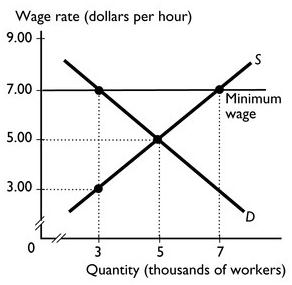 Unskilled Labor Market
Refer to Exhibit 4-10. Suppose that the government imposes a minimum wage of $7. The minimum wage will result in a ___________ of ________ thousand unskilled workers.
Unskilled Labor Market
Refer to Exhibit 4-10. Suppose that the government imposes a minimum wage of $7. The minimum wage will result in a ___________ of ________ thousand unskilled workers.
A) shortage; 2
B) shortage; 3
C) surplus; 2
D) surplus; 3
Correct Answer

verified
Correct Answer
verified
Multiple Choice
If the price of good X is $30 and the price of good Y is $5, it follows that the relative price of one unit of good X is approximately_____________ unit(s) of good Y.
A) 6.00
B) 2.00
C) 0.75
D) 0.25
E) 0.50
Correct Answer

verified
Correct Answer
verified
Multiple Choice
Exhibit 4-3 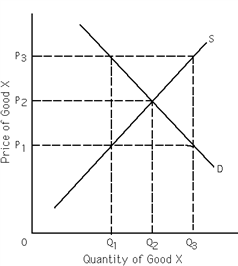 Refer to Exhibit 4-3. Which of the following is true?
Refer to Exhibit 4-3. Which of the following is true?
A) If price P1 is set as a price ceiling, the price ceiling will have an effect on the market for good X.
B) If price P1 is set as a price floor, the price floor will have an effect on the market for good X.
C) Price P1 is the equilibrium price for good X.
D) If price P1 is set as a price floor, then it is the highest price that can legally be charged in the market for good X.
Correct Answer

verified
Correct Answer
verified
True/False
A deadweight loss is the loss to society of not producing the supply-and-demand determined level of output.
Correct Answer

verified
Correct Answer
verified
Showing 21 - 40 of 123
Related Exams